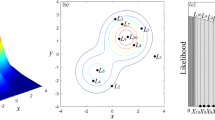Abstract
An alternative strategy for identifying sources of contamination in groundwater systems is presented. Under the assumption that the remediation cost is affected by the level of contamination, the proposed scheme provides probabilistic estimates of source locations and spill-time histories. Moreover, the method successfully assesses the relative importance of each potential source.
Similar content being viewed by others
References
Bagtzoglou, A.C. and Dougherty, D. E., 1990, Numerical solution of Fisher's equation using particle methods, in H. J. Morel-Seytoux (ed.),Proceedings 10th AGU Hydrology Days, Hydrology Days Publications, Fort Collins, Colorado, pp. 28–38.
Bagtzoglou, A. C., 1990, Particle-grid methods with application to reacting flows and reliable solute source identification, Ph D Dissertation, Department of Civil Engineering, University of California, Irvine.
Bagtzoglou, A. C., Dougherty, D. E., and Tompson, A. F. B., 1991, Projection functions for particle grid methods,J. Numer. Methods for Partial Differential Equations (accepted for publication).
Cady, R. and Neuman, S. P., 1985, Advection-dispersion with adaptive Eulerian-Lagrangian finite erlements,Proc. NATO Advanced Study Institute on Fundamentals of Transport Phenomena in Porous Media, Newark, Delaware, 1985.
Gorelick, S. M., Evans, B., and Remson, J., 1983, Identifying sources of groundwater pollution: An optimization approach,Water Resour. Res. 19, (3), 779–790.
Hockney, R. W. and Eastwood, J. W., 1988,Computer Simulation Using Particles, Adam Hilger, Bristol.
Kinzelbach, W., 1988, The random walk method in pollutant transport simulation, in E. Custodioet al. (eds.),Groundwater Flow and Quality Modelling, D. Reidel, Dordrecht, pp. 227–245.
Lindstrom, F. T. and Boersma, L., 1989, Two-dimensional transport and fate of chemicals emitted by arbitrarily placed sources in confined aquifers,Water Resour. Res. 25 (7), 1748–1756.
Tompson, A. F. B., Ababou, R., and Gelhar, L. W., 1987, Application and use of the three-dimensional turning bands random field generator: Single realization problems, Ralf M. Parsons Laboratory, MIT, Report 313.
Tompson, A. F. B., Ababou, R., and Gelhar, L. W., 1989, Implementation of the three-dimensional turning bands random field generator,Water Resour. Res. 25 (10), 2227–2243.
Tompson, A. F. B. and Gelhar, L. W., 1990, Numerical simulation of solute transport in three-dimensional, randomly heterogeneous porous media,Water Resour. Res. 26 (10), 2541–2562.
Wagner, B. J. and Gorelick, S. M., 1987, Optimal groundwater quality management under parameter uncertainty,Water Resour. Res. 23 (7), 1162–1174.
Wagner, B. J. and Gorelick, S. M., 1989, Reliable aquifer remediation in the presence of spatially variable hydraulic conductivity: From data to design,Water Resour. Res. 25 (10), 2211–2225.
Author information
Authors and Affiliations
Rights and permissions
About this article
Cite this article
Bagtzoglou, A.C., Dougherty, D.E. & Tompson, A.F.B. Application of particle methods to reliable identification of groundwater pollution sources. Water Resour Manage 6, 15–23 (1992). https://doi.org/10.1007/BF00872184
Received:
Accepted:
Issue Date:
DOI: https://doi.org/10.1007/BF00872184




